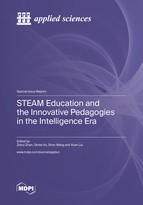STEAM Education and the Innovative Pedagogies in the Intelligence Era
A special issue of Applied Sciences (ISSN 2076-3417). This special issue belongs to the section "Computing and Artificial Intelligence".
Deadline for manuscript submissions: closed (31 October 2022) | Viewed by 38351
Special Issue Editors
Interests: learning science; STEAM education; smart education
Interests: information education and dissemination; media literacy; construction of smart campus; smart education theory and practice
Interests: management information systems
Special Issue Information
Dear Colleagues,
The value of STEAM education is widely acknowledged. It can motivate and support purposeful activity in learners and facilitate the development of a range of abilities. Introducing students to STEAM is at the forefront of educational reform. Besides, as we enter the era of intelligence, emerging technologies such as Artificial Intelligence (AI) and Internet of Things (IoT), machine learning, Augmented Reality (AR), Virtual Reality (VR), Mixed Reality (MR), intelligent computing, blockchain, open-source hardware, 3D printing, etc., have provided significant enlightenment to education, and empower transformative teaching for STEM/STEAM.
The assent of creativity, collaboration, and other 21st century competencies has urged educational reform to cultivate innovative talents. However, there is still a lack of research on how to properly integrate intelligent technologies with STEAM, or how to cultivate multiple abilities in students by utilizing the empowerment of new technologies. Without innovative pedagogies, it is difficult for teachers and students to participate in the STEAM practice in the era of intelligence. Hence, transformative teaching and learning methods target on STEAM education are in urgent need of development.
This Special Issue seeks excellent original research articles, including empirical study and reviews, that are related to STEAM education and the innovative pedagogies in the intelligence era. We welcome research from different disciplines and perspectives that covers the following topics contributing to STEAM/interdisciplinary education: first, high-quality scholarly reviews or meta-analyses in the field of creativity, innovation, and innovative pedagogies; second, empirical studies focusing on cultivating students’ higher-order abilities, such as creativity, critical thinking, collaboration, and other 21st century competencies. The third area could be practices of innovative pedagogies in the era of intelligence.
Topics of primary interest include but are not limited to:
- Innovative design of pedagogical content in STEAM
- Innovative practice approaches of STEAM
- Innovative evaluation of STEAM
- Intelligent environment of STEAM
- Innovative online/mixed STEAM
- Artificial Intelligence (AI) and STEAM
- STEAM education and creativity.
- STEAM education and culture in the intelligence era.
- STEAM education and educational equality in the intelligence era.
- STEAM education towards the cultivation of future talents.
- Security, trust, and collaboration in STEAM
Prof. Dr. Zehui Zhan
Prof. Dr. Qintai Hu
Dr. Shan Wang
Dr. Xuan Liu
Guest Editors
Manuscript Submission Information
Manuscripts should be submitted online at www.mdpi.com by registering and logging in to this website. Once you are registered, click here to go to the submission form. Manuscripts can be submitted until the deadline. All submissions that pass pre-check are peer-reviewed. Accepted papers will be published continuously in the journal (as soon as accepted) and will be listed together on the special issue website. Research articles, review articles as well as short communications are invited. For planned papers, a title and short abstract (about 100 words) can be sent to the Editorial Office for announcement on this website.
Submitted manuscripts should not have been published previously, nor be under consideration for publication elsewhere (except conference proceedings papers). All manuscripts are thoroughly refereed through a single-blind peer-review process. A guide for authors and other relevant information for submission of manuscripts is available on the Instructions for Authors page. Applied Sciences is an international peer-reviewed open access semimonthly journal published by MDPI.
Please visit the Instructions for Authors page before submitting a manuscript. The Article Processing Charge (APC) for publication in this open access journal is 2400 CHF (Swiss Francs). Submitted papers should be well formatted and use good English. Authors may use MDPI's English editing service prior to publication or during author revisions.






